(Useful for the coming World War times when the doctors, medicines etc. will not be available and at other times too!)
Saints, Prophets, Astrologers and others have predicted that the coming times are going to be very adverse, when besides our own health, caring for the health of our relatives will be a big challenge. During adversities, usually communication breaks down. It becomes difficult to take patients to a hospital, contact some doctor or buy medicines.
Sanatan Sanstha has published a Holy text series that will help in facing these adverse times. As of 30.12.2016, there are 12 Holy texts in this series. ‘Acupressure’ is one among these. We will be serially reproducing important parts from these Holy texts.
At the slightest indication of unease, we visit a doctor. Instead, if we use Acupressure therapy, it will not only save our valuable time and money, but will also help us treat the root cause of the ailment.
Most people think that Acupressure therapy originated in China; however, the therapy has originated in Bharat only.
1. Meaning of ‘Acupressure Therapy’
Acupressure Therapy means applying pressure on specific points on the body of an individual, thus activating his internal organs and through this process, improving the health of the individual.
2. Fundamental principle
underlying Acupressure treatment
There is uninterrupted flow of Chetana (Aspect of Chaitanya which governs the functioning of the mind and body) in the human body. Wherever blocks develop in the flow of Chetana, it leads to ailment of the associated organ. These blocks can be eliminated by pressing specific points on the body. These specific points are known as pressure-points.
3. Instructions regarding Acupressure therapy
3A. Commence Acupressure
therapy with a prayer to your Deity of worship
Pray thus – O’ Goddess ! It is by Your grace that I am able to administer Acupressure treatment on myself. I pray unto Your Holy feet for speedy recovery from the ailment (Name the ailment).
3B. Chanting should be done
by those suffering from Negative Energy
Everyone, especially those who are suffering from distress due to negative energies, should chant during the treatment
3C. Instructions regarding pressing the pressure-points
- Apply pressure on the pressure-points using the thumb, index finger, a pencil that is not sharpened, the smooth end of a pen or something similar.
- While pressing points on a finger, support the finger to be pressed with the index finger and press with the thumb. The roles of these two fingers can be alternated.
- Apply as much pressure as the patient is be able to tolerate.
- Do not apply continuous pressure; instead, press for a second, release for a second and repeat.
- Press a pressure-point for about 1-2 minutes.
- Till the ailment is cured, continue the Acupressure treatment minimum once a day and a maximum 4-5 times a day.
- Though Acupressure treatment can be administered any time of the day, it is appropriate not to administer the treatment about an hour after meals.
4. Instructions regarding the
description of pressure-points in this article
A. Words preceding the pressure-point such as (H 7), (LI 4) are actually the names of the respective pressure-points according to Acupressure therapy.
B. Other than the pressure-points on the vertical line dividing the body, rest of the points are symmetrically placed on either side of the body. During therapy, press the points on both the sides.
C. Length-width of every part of the human body is proportional to the width of the individual’s fingers. Hence, measurements for locating various pressure-points have been mentioned in terms of width of the fingers. According to this, width of 1 finger is taken to be width of the middle phalanx of any finger.
5. Pressure-points associated with common ailments
5A.Tiredness
- Press the root of the little toe from all sides.
- Press the central phalanx of the little finger from all sides.
5B.Obesity
- Heart 7 (H 7) : The point on the fold of the wrist where a straight line from the web between ring and little finger meets. (Point 1 in figure 1.)
- Pericardium 6 (P 6) : Two thumbs (Please see Note) below on the straight line from the midpoint of the fold on the wrist (Point 2 in figure 1.)
Note – Distance of 1 thumb is width of the middle phalanx of thumb.
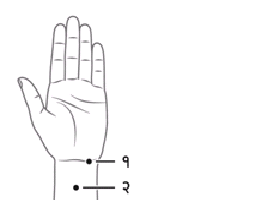
5C. Fever
- Heart 7(H 7) : See Point 1 of Point 5B
- Large intestine 4 (LI 4) : A fleshy mound is created at the fold when the thumb and index finger are held together. The topmost point on this mound. (Point 1 in figure 2.)

6. Pressure-points associated
with ailments of the head and brain
6A. Headache
- Gall bladder 14 (GB 14) : On the forehead, one thumb above the middle of each brow (Point 1 in figure 3.).
- Triple warmer 23 (TW 23) : On the outer tip of the brows (Point 2 in figure 3.).
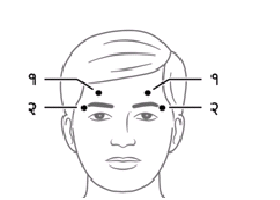
6B. Insomnia (Sleeplessness)
- Heart 7 (H 7) : See Point 1 of Point 5B.
- Pericardium 6 (P 6) : See Point 2 of Point 5B.
7. Pressure-points associated with all eye ailments
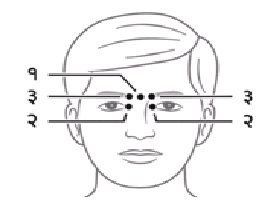
- Exceptional 1 (Ex 1) : Mid Brow region (Point 1 in figure 4).
- Urinary bladder 1 (UB 1) : On the inner corner of the eye (Point 2 in figure 4).
- Urinary bladder 2 (UB 2) : Near inner tip of the eye-brow (Point 3 in figure 4).
- Exceptional 3 (Ex 3) : Middle of the eye-brow (Point 1 in figure 5).
- Triple warmer 23 (TW 23) : On the outer tip of the eye-brow (Point 2 in figure 5).
- Gall bladder 1 (GB 1) : On the outer corner of the eye (Point 3 in figure 5).
- Stomach 1 (St 1) : Midpoint of the lower edge of the eye socket (Point 4 in figure 5).
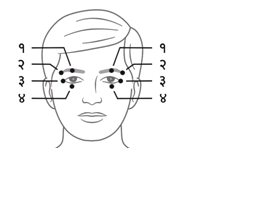
8. Pressure-points on common
cold and blocking of the nose because of the cold
- Stomach 1 (St 1) : Mid-point of the lower edge of the eye socket. (Point ‘1’ in figure ‘6’.)
- Stomach 2 (St 2) : One finger below the mid-point of the lower edge of the eye socket. (Point ‘2’ in figure ‘6’.)
- Large intestine 20 (LI 20) : On the outer side of the nostril. (Point ‘3’ in figure ‘6’.)
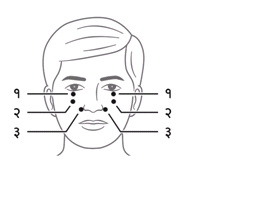
9. Pressure-points associated with cough
- Urinary bladder 11 (UB 11) : After bending the head forward fully, two vertebral protrusions are felt prominently on the lower side of the neck. Two thumbs on the side from the central line in line with bottom vertebra. (Point ‘1’ in figure ‘7’.)
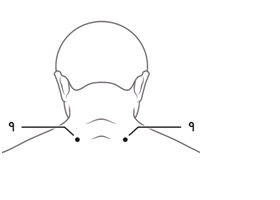
- Kidney 1 (Ki 1) : At 4 fingers on the line from the web of the second and the third toe (Point ‘1’ in figure ‘8’.)
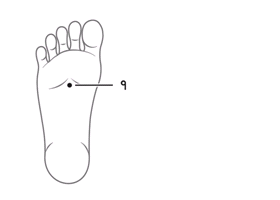
10. Pressure-points
associated with High blood pressure
- Heart 3 (H 3) : The point where the fold of the elbow ends on the inner side when the hand is fully folded at the elbow. (Point ‘1’ in figure ‘9’.)
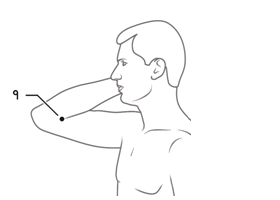
11. Pressure-points associated
with ailments of the digestive system
- Vomiting and acidity : Pericardium 6 (P 6) : Refer Point ‘2’ from the Point ‘5B’
- Constipation : Press mid-point of the chin. (Point ‘1’ in figure ‘10’.)
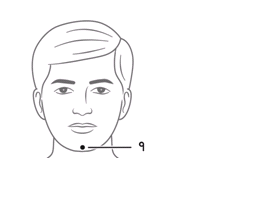
- Large intestine 4 (LI 4) : Refer Point ‘2’ from the Point ‘6C’.
- Pull the stomach in and release 10 times when the stomach is empty.
- Loose motions: Large intestine 4 (LI 4) : See Point ‘2’ from the Point ‘6C’.
12. Pressure-points associated
with ailments associated with the menstrual cycle
On both the sides of the wrist, from the fold up to four fingers width. (See Figure ‘11’)
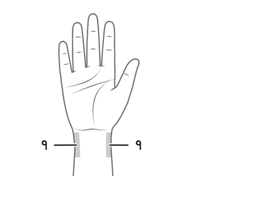
13. Pressure-points associated with mental stress
- Governing vessel 20 (GV 20) : Point on the mid-point of the skull on the line joining the opening of ear canals. (Point ‘1’ in figure ‘12’.)
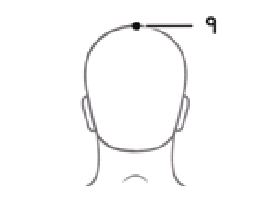
- Heart 7 (H 7) : Refer sub-point ‘1’ from Point ‘5B’.
- Pericardium 6 (P 6) : Refer sub-point ‘2’ from Point ‘5B’.
14. Pressure-points helpful for good health
- Heart 7 (H 7) : Refer sub-point ‘1’ from Point ‘5B’.
We have introduced this therapy in Volume 1 : ‘Acupressure Therapy (Intro-duction)’; whereas, Volume 2 : ‘Acupressure therapy for common ailments’ covers treatment for over 80 day-to-day ailments.
Besides, these Holy texts also cover pressure-points to be pressed daily for remaining healthy. Readers should have these two Holy texts in their collection.

 Herbal, Spiritual and Musical remedies to beat the heat
Herbal, Spiritual and Musical remedies to beat the heat Guiding principles for homeopathy treatment
Guiding principles for homeopathy treatment  Homeopathic and Biochemic remedies for eye problems
Homeopathic and Biochemic remedies for eye problems Monsoon and milk
Monsoon and milk Water : How and how much to drink every day?
Water : How and how much to drink every day? Acidity : Causes, Symptoms, and Remedy
Acidity : Causes, Symptoms, and Remedy